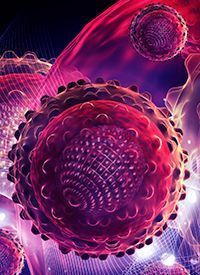C-CAR066 Achieves High Marks in Relapsed/Refractory B-NHL
C-CAR066 exhibited a favorable safety profile and promising efficacy in adult patients with relapsed/refractory B-cell non-Hodgkin lymphoma who failed with prior CD19 CAR T-cell therapy.

C-CAR066, a novel 2nd generation chimeric antigen receptor (CAR) T-cell therapy targeting the CD20 antigen, exhibited a favorable safety profile and promising efficacy in adult patients with relapsed/refractory (R/R) B-cell non-Hodgkin lymphoma (B-NHL) who failed with prior CD19 CAR T-cell therapy, according to results from a phase 1 study (NCT04036019) in China presented during the 2021 ASCO Annual Meeting.
In a population of 10 patients, at a median follow-up of 4.2 months (range, 1.2-11.7), C-CAR066 elicited an overall response rate (ORR) of 100%; 7 patients had a complete response, and 3 patients had a partial response. The median time to response was 1 month (range, 0.9-2.7) and the median time to CR was 2.7 months (range, 0.9-2.9). The median duration of response (DOR) was not reached (NR; range, 1.0-NR).
“I think these results are very amazing,” said Aibin Liang, MD, PhD, lead study author and professor of medicine at Tongji Hospital of Tongji University in Shanghai, China. “This population is very heavily [pre]treated.”
C-CAR066 previously exhibited higher in vitro reactivitythan other anti-CD20 single-chain variable fragments, including Leu16, obinutuzumab (Gazyva), and rituximab (Rituxan). In vitro and in vivo anti-tumor activity was also greater with C-CAR066 compared with other CAR T therapies containing Leu16.
The agent is manufactured in a serum-free manner, utilizing a functionally closed and highly automated system. The manufacturing success rate in the trial was 100%. The median manufacture time of C-CAR066 was 7 days.
The study, which was conducted at 2 sites in China, was the first in human, open-label study of C-CAR066. In order to be eligible for the trial, patients had to be aged 18 to 75 years with a measurable lesion, no active infection, adequate organ function, and no central nervous system lesions.
Patients were administered a lymphodepletion regimen of 3-day cyclophosphamide (300 mg/m2) plus fludarabine (30 mg/m2); bridging therapy was permitted. C-CAR066 was given as a single infusion at a dose of 1.0 to 5.0 x 106/kg. The median vein to vein time was 20 days (range, 17-91). Assessments and follow-up occurred from day 1 to month 24 of the study.
The primary objective of the study was to determine the incidence and severity of treatment emergent adverse events (TEAE), per common terminology criteria for adverse events (CTCAE) v5.0 and American Society for Transplantation and Cellular Therapy guidelines. Secondary objectives included ORR, DOR, progression-free survival, and overall survival. CAR T expansion and persistence were considered exploratory objectives.
The study population was heavily pretreated, with patients receiving a median of 5 (range, 2-6) prior lines of therapy. The median age was 55.5 years (range, 41-67), with 2 patients over 65 years. Most patients (n = 9) had an ECOG performance score of 1, and 6 patients registered an International Prognostic Index score of 3 to 5. The study was evenly divided with 5 male patients and 5 female patients.
Patients with diffuse large B-cell lymphoma (DLBCL) made up a majority of the study population (n = 8); the remaining 2 patients had transformed follicular lymphoma. Additionally, there were 4 patients with double-expressor lymphoma and 9 with Ann Arbor stage III/IV disease.
The median DOR of prior CAR T therapy was 2.1 months (range, 0.7-12.6). All patients responded to prior therapy; 2 had CRs and 8 experienced a PR. A Bruton tyrosine kinase inhibitor was previously administered to 2 patients and 6 patients had prior lenalidomide therapy. Bridging therapy was used in 4 patients.
Regarding safety, 9 patients experienced cytokine release syndrome (CRS) of any grade and grade 4 CRS was reported for 1 patient. The median days to onset of CRS was 2 (range, 1-9), and the median time to resolution was 4 days (range, 2-17). The patient with grade 4 CRS presented with high fever, hypotension, and hypoxia on day 6 and resolved on day 10. This patient was treated with tocilizumab, steroids, noninvasive ventilation support, and was not admitted to the intensive care unit.
Other common AEs of any grade included neutropenia (100%), anemia (100%), thrombocytopenia (70%), and infection (70%). AEs grade 3 or higher included neutropenia (80%), anemia (50%), thrombocytopenia (30%), and infection (10%). Notably, there were no immune effector cell-associated neurotoxicity syndrome events.
“C-CAR066 showed very promising clinical benefits in patients with relapsed/refractory DLBCL following failure of C19 CAR T therapy,” Liang concluded. “These are patients with a high, unmet medical need. Many further studies are planned.”
Reference
Liang A, Ye S, Li P, et al. Safety and efficacy of a novel anti-CD20 chimeric antigen receptor (CAR)-T cell therapy in relapsed/refractory (r/r) B-cell non-Hodgkin lymphoma (B-NHL) patients after failing CD19 CAR-T therapy. J Clin Oncol. 2021;39(suppl 15):2508. doi:10.1200/JCO.2021.39.15_suppl.2508